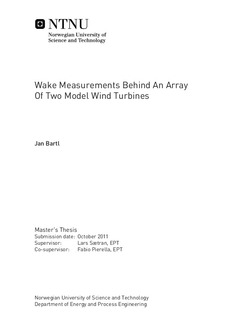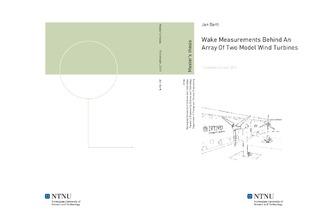| dc.contributor.advisor | Sætran, Lars | nb_NO |
| dc.contributor.advisor | Pierella, Fabio | nb_NO |
| dc.contributor.author | Bartl, Jan | nb_NO |
| dc.date.accessioned | 2014-12-19T11:47:58Z | |
| dc.date.available | 2014-12-19T11:47:58Z | |
| dc.date.created | 2011-11-29 | nb_NO |
| dc.date.issued | 2011 | nb_NO |
| dc.identifier | 460145 | nb_NO |
| dc.identifier | ntnudaim:6918 | nb_NO |
| dc.identifier.uri | http://hdl.handle.net/11250/234542 | |
| dc.description.abstract | During the last decades the exploitation of energy from the wind has become one of the most promising renewable energy technologies. The main strive in today s development of wind turbines is to increase the efficiency of the turbine and to build bigger rotors that are able to extract more power out of the wind.When it comes to the planning and designing of a wind park, also the aerodynamic interactions between the single turbines must be taken into account. The flow in the wake of the first row turbines is characterized by a significant deficit in wind velocity and by increased levels of turbulence. Consequently, the downstream turbines in a wind farm cannot extract as much power from the wind anymore. Furthermore, the additional turbulence in the wake could be a reason for increased material fatigue through flow-induced vibrations at the downstream rotor.The main focus of this experimental study is to investigate the local velocity deficit and the turbulence intensities in the wake behind an array of two model wind turbines. For two different turbine separation distances, the wake is scanned at several different downstream positions behind the second model turbine. Thus, it is possible to map the axial development of mean velocity and turbulence intensity and to evaluate the influence of turbine separation distance. Furthermore, the effect of varying tip speed ratios of the first and second turbine onto the wake flow field is investigated.The experiments are performed at the wind tunnel (1.9m x 2.7m cross section) at NTNU Trondheim using two model wind turbines with a rotor diameter of 0.9m. A hot wire probe is used to scan the wake behind the model turbines in defined positions.The velocity deficit and the turbulence intensity behind an array of two turbines are found to be significantly higher than behind one unobstructed turbine. Moving axially downstream, a gentle broadening of the wake can be observed. The wake profiles measured in close distances behind the rotor are characterized by evident asymmetries. Further downstream in the wake, the flow field becomes more symmetrical. The flow conditions in the inner part of the wake behind the two turbines are observed to be mainly dominated by the operational characteristics of the second turbine rotor. Although the first turbine has hardly any influence on the inner part of the wake, the outer dimensions of the wake can be tracked back to the influence of the first turbine. | nb_NO |
| dc.language | eng | nb_NO |
| dc.publisher | Institutt for energi- og prosessteknikk | nb_NO |
| dc.subject | ntnudaim:6918 | no_NO |
| dc.subject | IVTDIV Diverse studier ved IVT | no_NO |
| dc.subject | | no_NO |
| dc.title | Wake Measurements Behind An Array Of Two Model Wind Turbines | nb_NO |
| dc.type | Master thesis | nb_NO |
| dc.source.pagenumber | 129 | nb_NO |
| dc.contributor.department | Norges teknisk-naturvitenskapelige universitet, Fakultet for ingeniørvitenskap og teknologi, Institutt for energi- og prosessteknikk | nb_NO |

